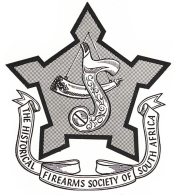
Incorporating HFSSA Page
History of the Historical Firearms Society of South Africa (HFSSA)
In 1954, a group of about 20 firearm enthusiasts gathered to shoot antique and vintage
weapons. They initially met at Sandy Bay’s sand dunes, later moving to a quarry near Hout
Bay and eventually to Devil’s Peak. Their collection included a variety of historical firearms
such as Winchesters, Westley Richards “Monkey Tails”, Enfields, Martini-Henrys, and
Dutch Muskets.
By 1958, disagreements led to the formation of two separate groups:
- The South African Firearms Club - open to all types of weapons.
- The South African Muzzle Loaders Association - dedicated to antique and vintage arms.
The latter was founded by nine members, including Brig. Louis Wolf (Chairman),
Bill Hibbard (Vice Chairman), and Barry Berkovitch.
Objectives of the Society:
- Promote interest in antique firearms, particularly those used in South Africa.
- Test and demonstrate their capabilities under strict range rules.
- Collaborate with similar organizations worldwide.
- Publish a journal on historical firearms.
- Hold educational meetings and discussions.
- Ensure members comply with firearm laws.
- Manage subscriptions and funds for the society.
Early Activities and Growth
The society held its first meeting in September 1958 at Brig. Wolf’s office in Youngsfield.
In 1959, they secured permission to use the Bellville Military Shooting Range. At the time,
private gunpowder ownership was illegal, so members extracted black powder from 12-bore blanks.
In 1961, Brig. Wolf secured a permit, allowing legal storage and use.
By 1963, the society imported its first official stock of Curtis & Harvey gunpowder.
Strict safety measures were implemented following an incident where a powder flask exploded
(fortunately without injuries).
The society grew internationally, affiliating with muzzle-loading associations in Britain and the U.S.
It participated in postal shooting competitions and helped change South African laws in 1964 to allow private
gunpowder ownership. Over time, HFSSA became the National Union for Black Powder Shooting in
South Africa and later joined the Muzzle Loading Associations International Committee (MLAIC).
Achievements and Cultural Contributions
HFSSA members raised funds to send teams to international competitions, where they won multiple medals.
The society also organized historical shooting events, including a notable 1982 match recreating an
1860s target shoot.
By the 1980s, black powder shooting had grown significantly, leading to the formation of an independent
governing body overseeing seven clubs nationwide.
On the cultural side, HFSSA published its first journal in 1959, with only 30 copies. By 1960, it became a
biannual publication and continued until 1986, when it was replaced by a newsletter. The society officially
changed its name in 1962 to better reflect its focus.
HFSSA contributed to firearm education, assisting museums with identification and restoration.
It organized four major exhibitions, including displays at the Cultural History Museum and a gun trade expo.
The society also helped restore historical artifacts, such as the grave of George Kynoch in Johannesburg.
Decline and Amalgamation with SAAACA
Membership peaked at 650 in 1990, with members in 17 countries. However, stricter gun laws in the late 1980s
and 1990s, including licensing requirements for antique firearms and storage regulations, led to a decline in
interest. Many collections were sold overseas, and fewer new members joined.
Despite efforts by Barry Berkovitch and a small committee to revive the society in 1994, his passing in 1998
left HFSSA struggling. To preserve its legacy, the remaining members voted to merge with the
Southern Africa Arms and Ammunition Collectors Association (SAAACA). Today, HFSSA’s knowledge and
expertise continue within SAAACA, ensuring its contributions to firearm history are not forgotten.
Adapted from the original text, Andrew Appleby (HFSSA Caretaker Secretary, 1999)

